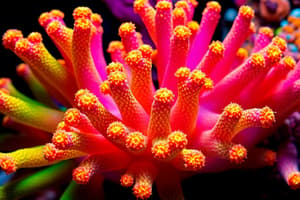Podcast
Questions and Answers
Which of the following statements is false?
Which of the following statements is false?
- Choanocytes have flagella that propel water through the body.
- Porocytes control the flow of water through pores in the sponge body.
- Lophocytes secrete collagen.
- Pinacocytes can transform into any cell type. (correct)
Which of the following statements about the anatomy of a mollusk is false?
Which of the following statements about the anatomy of a mollusk is false?
The digestive system includes a gizzard, a stomach, a digestive gland, and the intestine.
Which of the following statements about insects is false?
Which of the following statements about insects is false?
The trachea is part of the digestive system.
Mesohyl contains:
Mesohyl contains:
The large central opening in the parazoan body is called the:
The large central opening in the parazoan body is called the:
What is a key limitation of sponge body plans?
What is a key limitation of sponge body plans?
Cnidocytes are found in
Cnidocytes are found in
Cubozoans are
Cubozoans are
To which class does a sessile Cnidarian that buds medusas belong?
To which class does a sessile Cnidarian that buds medusas belong?
Which group of flatworms are primarily ectoparasites of fish?
Which group of flatworms are primarily ectoparasites of fish?
The rhynchocoel is a
The rhynchocoel is a
Annelids have:
Annelids have:
A mantle and mantle cavity are present in:
A mantle and mantle cavity are present in:
How does segmentation enhance annelid locomotion?
How does segmentation enhance annelid locomotion?
The embryonic development in nematodes can have up to __________ larval stages.
The embryonic development in nematodes can have up to __________ larval stages.
The nematode cuticle contains _____.
The nematode cuticle contains _____.
Crustaceans are _____.
Crustaceans are _____.
Flies are_______.
Flies are_______.
Which of the following is not a key advantage provided by the exoskeleton of terrestrial arthropods?
Which of the following is not a key advantage provided by the exoskeleton of terrestrial arthropods?
Echinoderms have _____.
Echinoderms have _____.
The circulatory fluid in echinoderms is _____.
The circulatory fluid in echinoderms is _____.
Which of the following features does not distinguish humans as a member of phylum Chordata?
Which of the following features does not distinguish humans as a member of phylum Chordata?
The sister taxon of the Chordata is the _____.
The sister taxon of the Chordata is the _____.
Flashcards are hidden until you start studying
Study Notes
Sponges
- Choanocytes possess flagella to propel water through the sponge's body.
- Pinacocytes do not have the ability to transform into any cell type.
- Porocytes regulate water flow through the sponge's pores.
- Mesohyl is a gelatinous substance containing collagen and various cells for sponge functions.
- The osculum is the large central opening in a sponge's body.
- Sponge body plans are variations of a tube-within-a-tube design, limited by reliance on osmosis and diffusion, necessitating a high surface area to volume ratio.
Cnidarians
- Cnidocytes are specialized cells found in the Phylum Cnidaria.
- Cubozoans exhibit polymorphism within their life cycle.
- The Class Scyphozoa includes sessile Cnidarians that produce medusas, which swim by contracting muscle rings in their bells.
Flatworms
- Monogeneans, a group of flatworms, primarily act as ectoparasites of fish.
Nematodes
- Nematodes can undergo up to four larval stages during embryonic development.
- Their cuticle is composed of chitin, providing structural support.
Annelids
- Annelids feature a true coelom, enhancing bodily compartmentalization and function.
- Segmentation allows for localized muscle contractions, facilitating coordinated locomotion.
Mollusks
- Mollusks possess a mantle and a mantle cavity which play essential roles in their physiology.
Arthropods
- Crustaceans belong to the Ecdysozoans clade and undergo molting.
- Flies are classified as hexapods with six limbs.
- Terrestrial arthropods' exoskeletons provide many advantages, but they do not grow consistently with the organism throughout its life.
Echinoderms
- Echinoderms are characterized by pentaradial symmetry.
- Their circulatory system relies on water as the circulatory fluid.
Chordates
- Humans are classified within the phylum Chordata; however, the feature of indeterminate cleavage in embryos does not distinguish them as part of this group.
- The sister taxon to Chordata is the Ambulacraria.
Studying That Suits You
Use AI to generate personalized quizzes and flashcards to suit your learning preferences.




